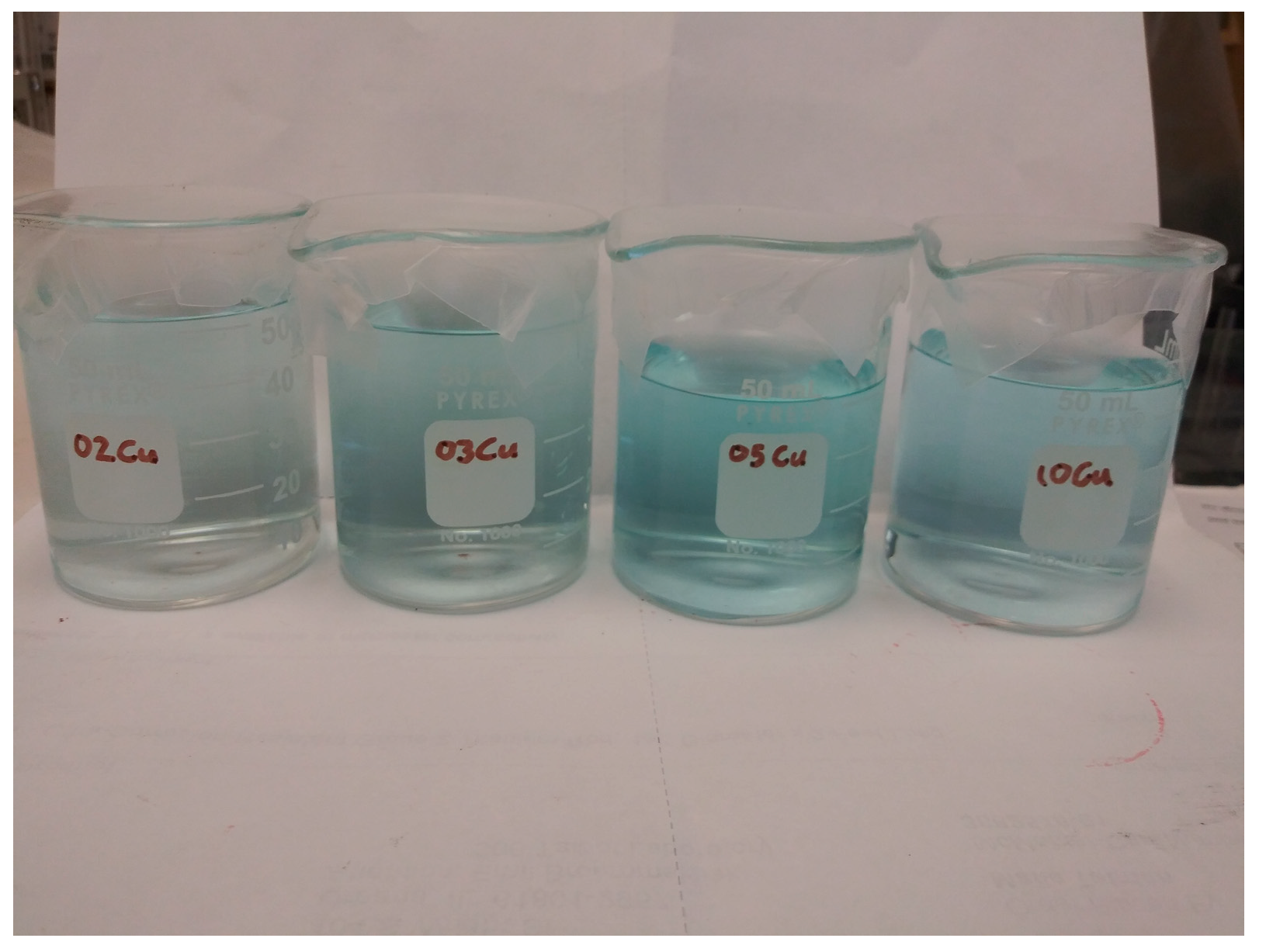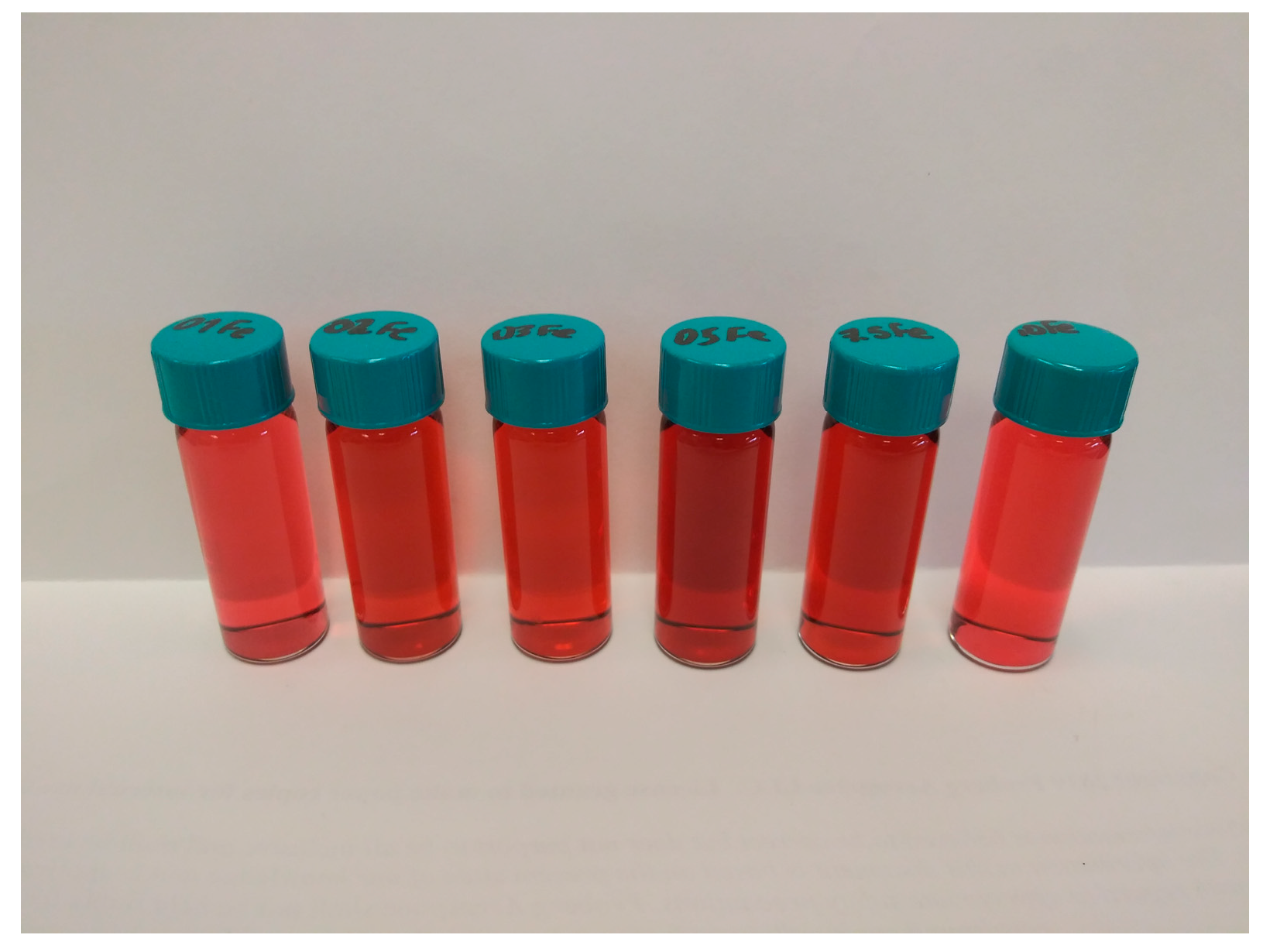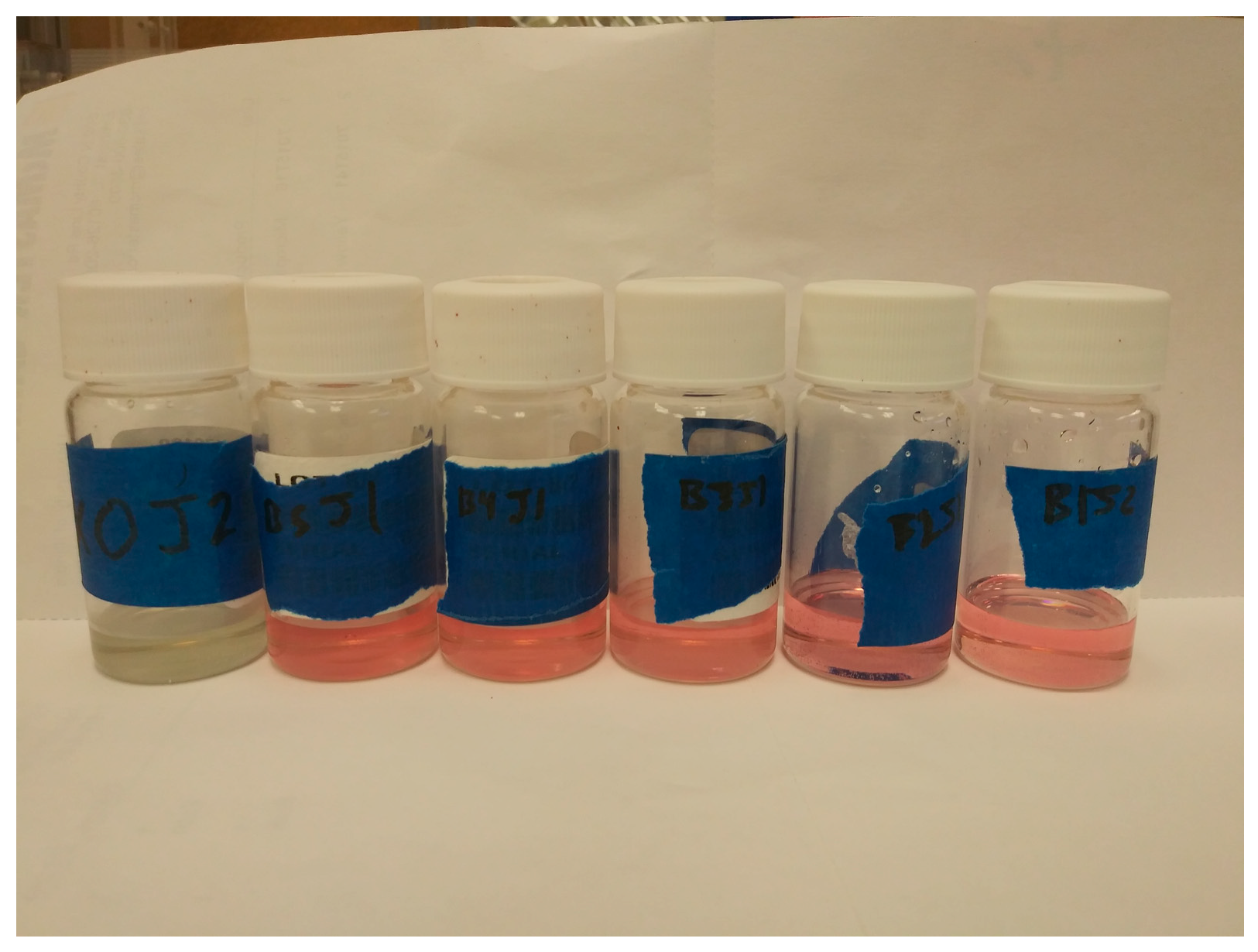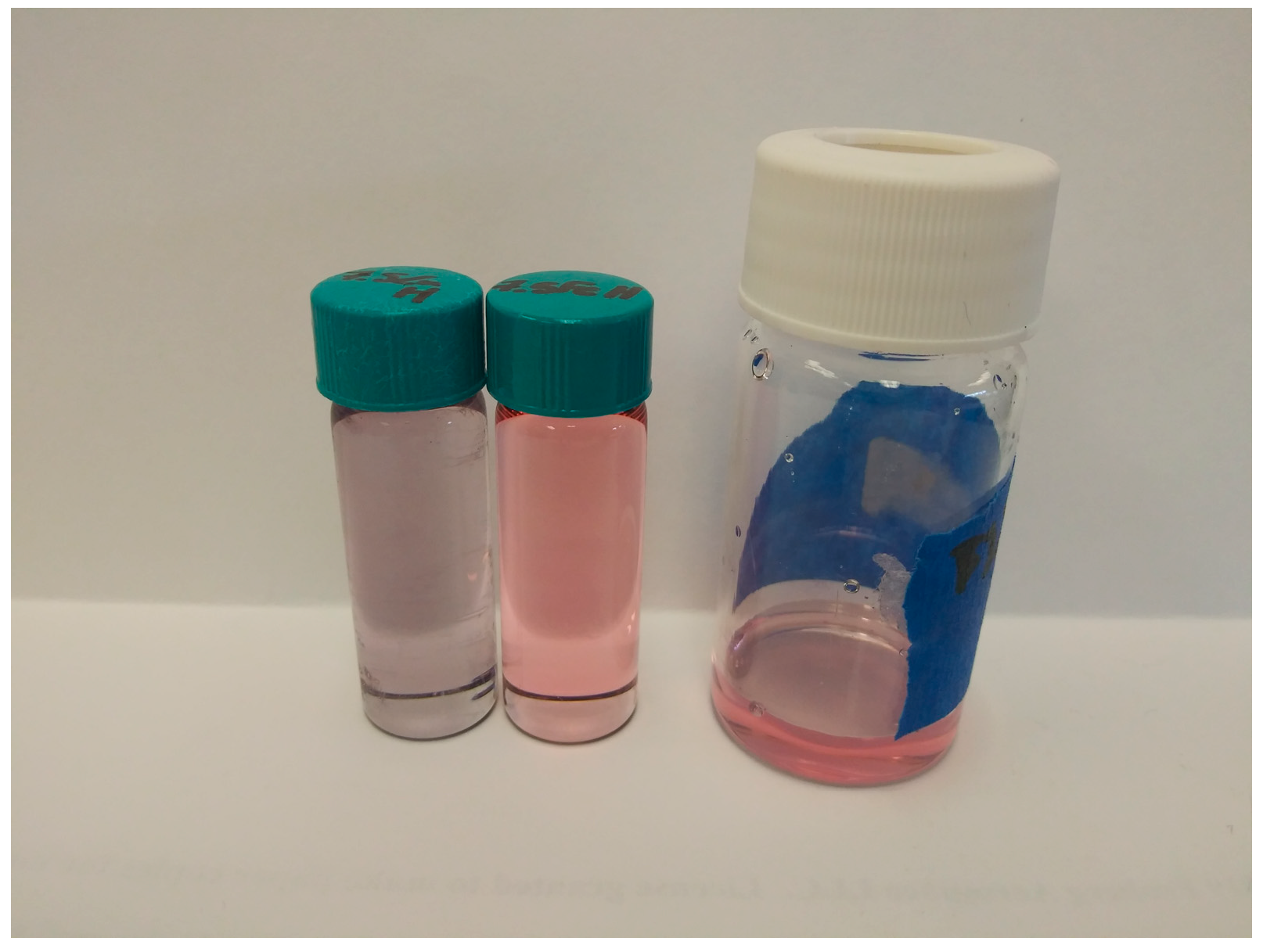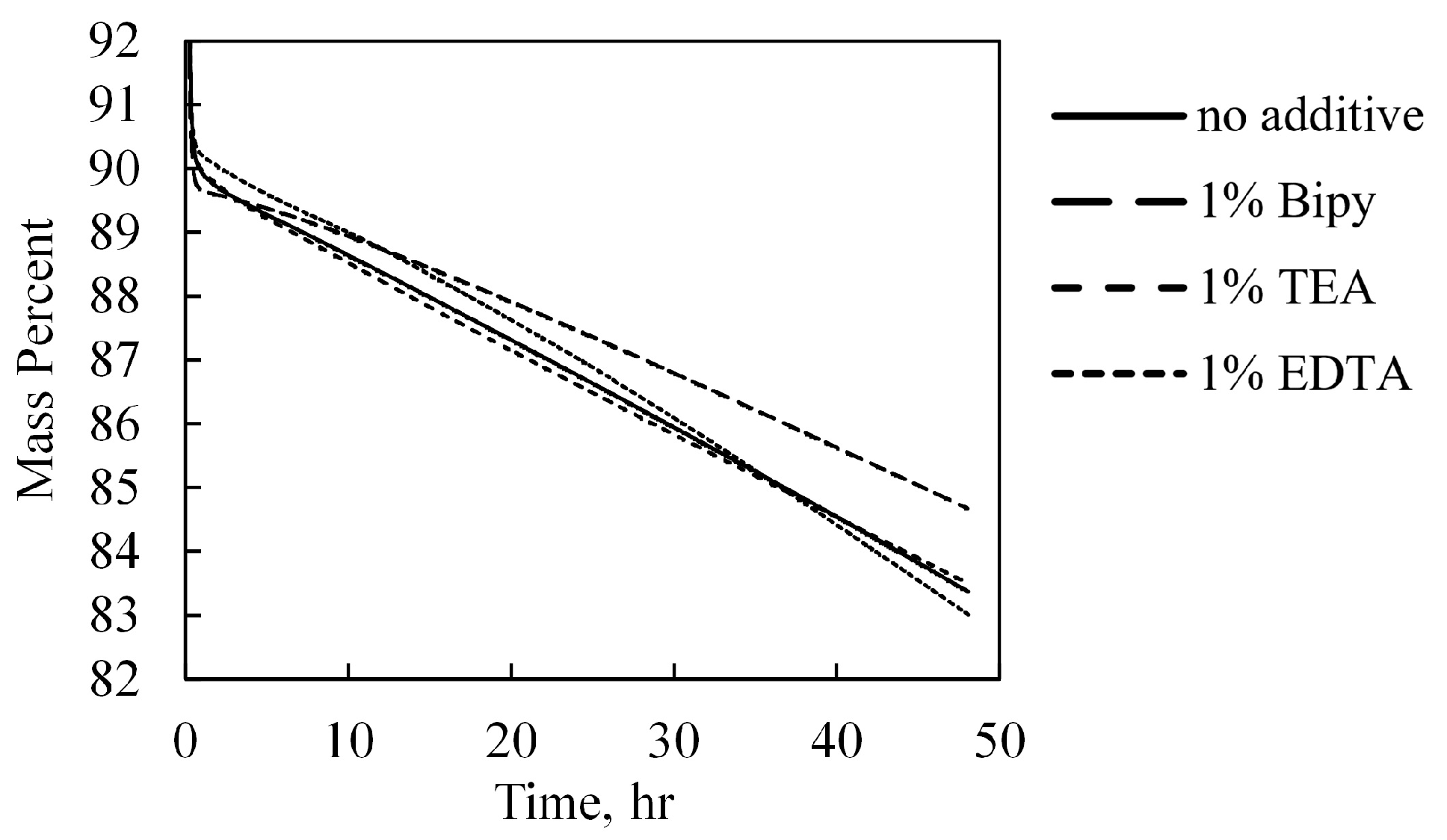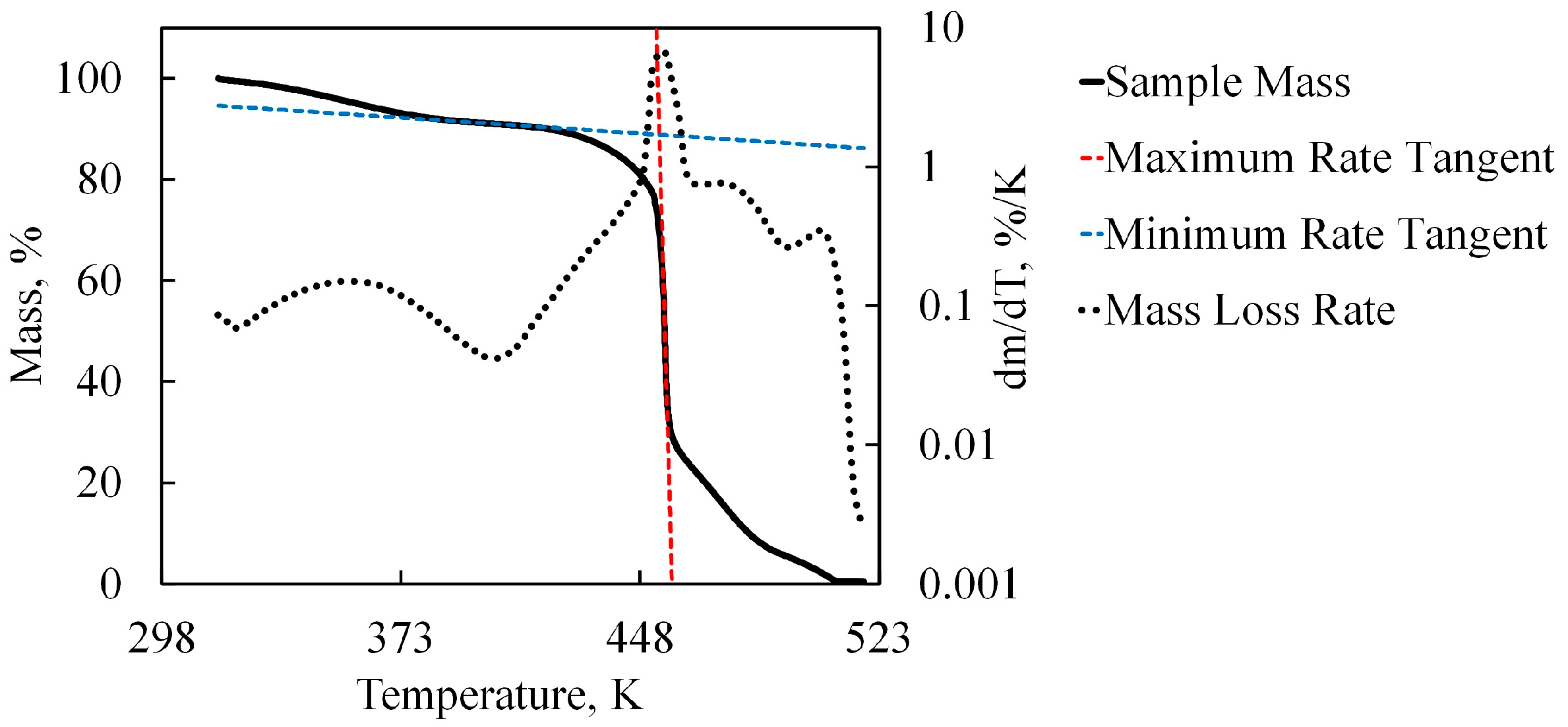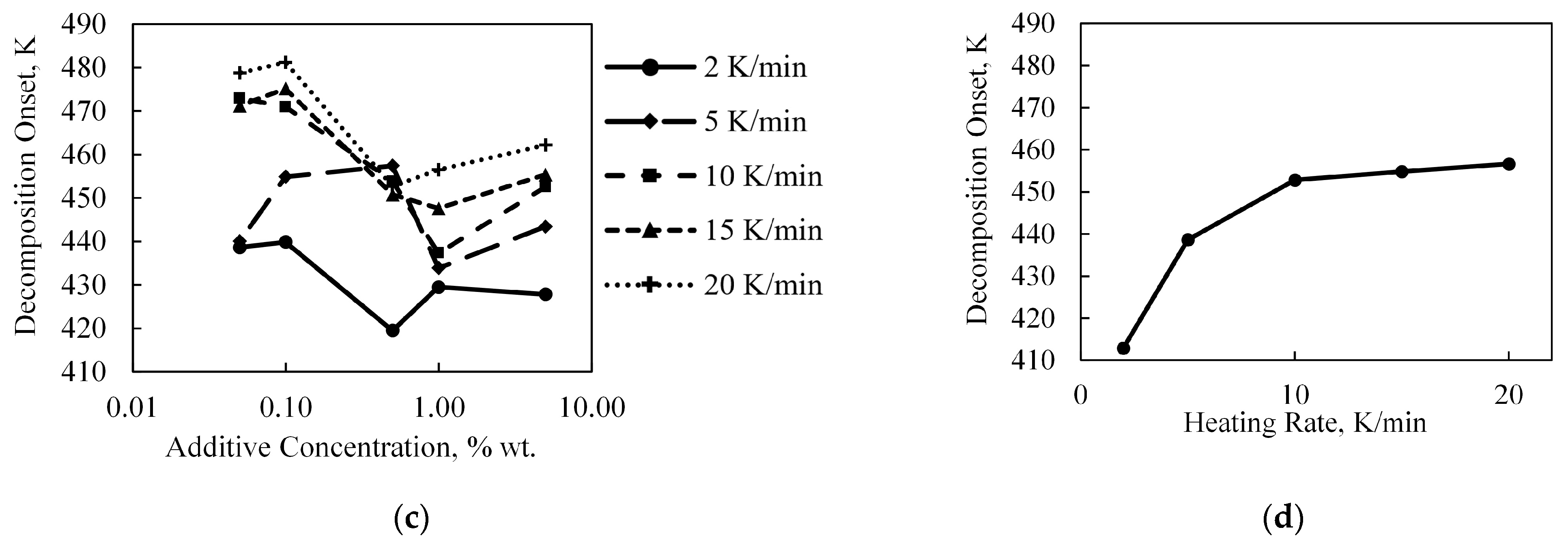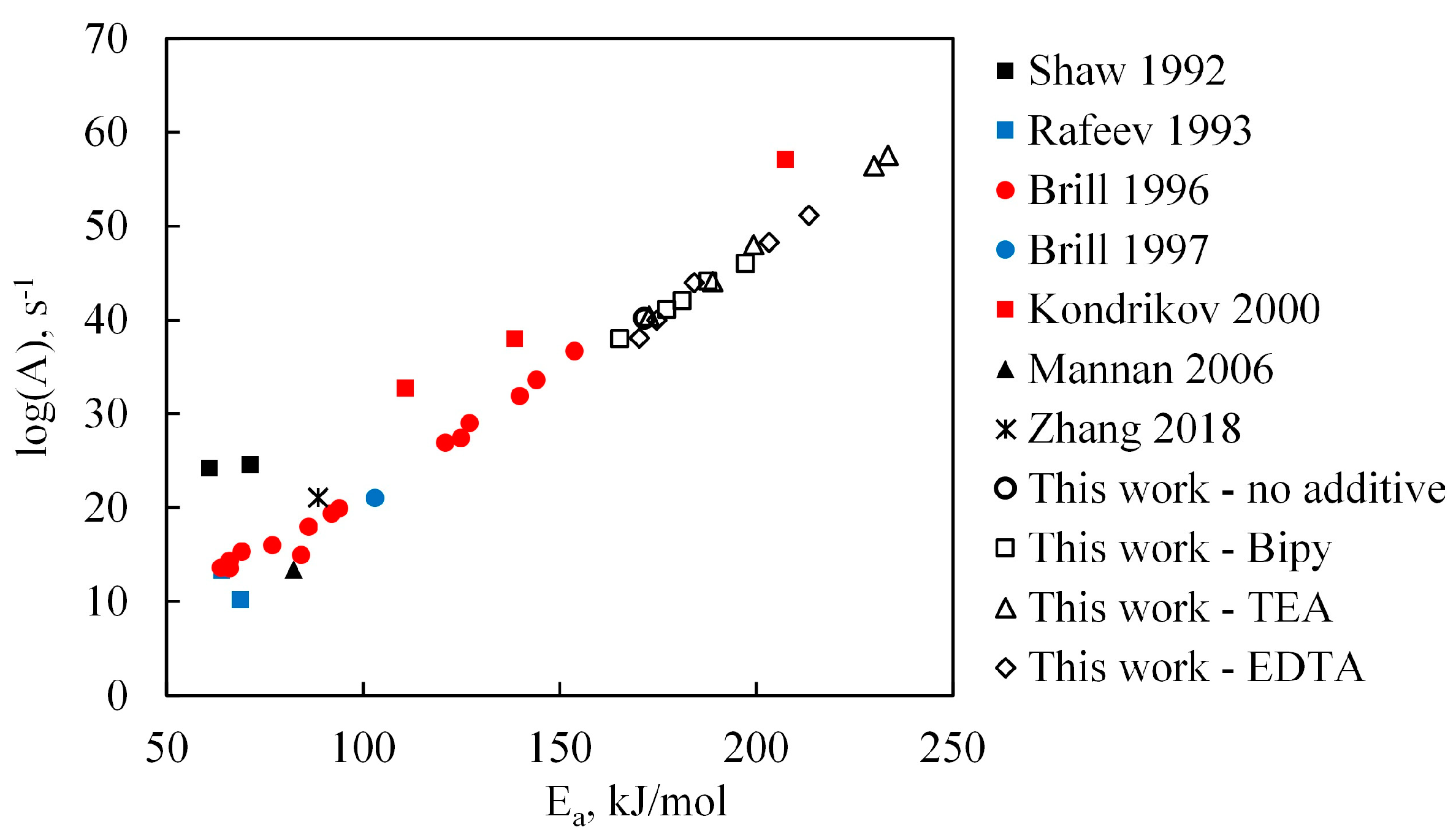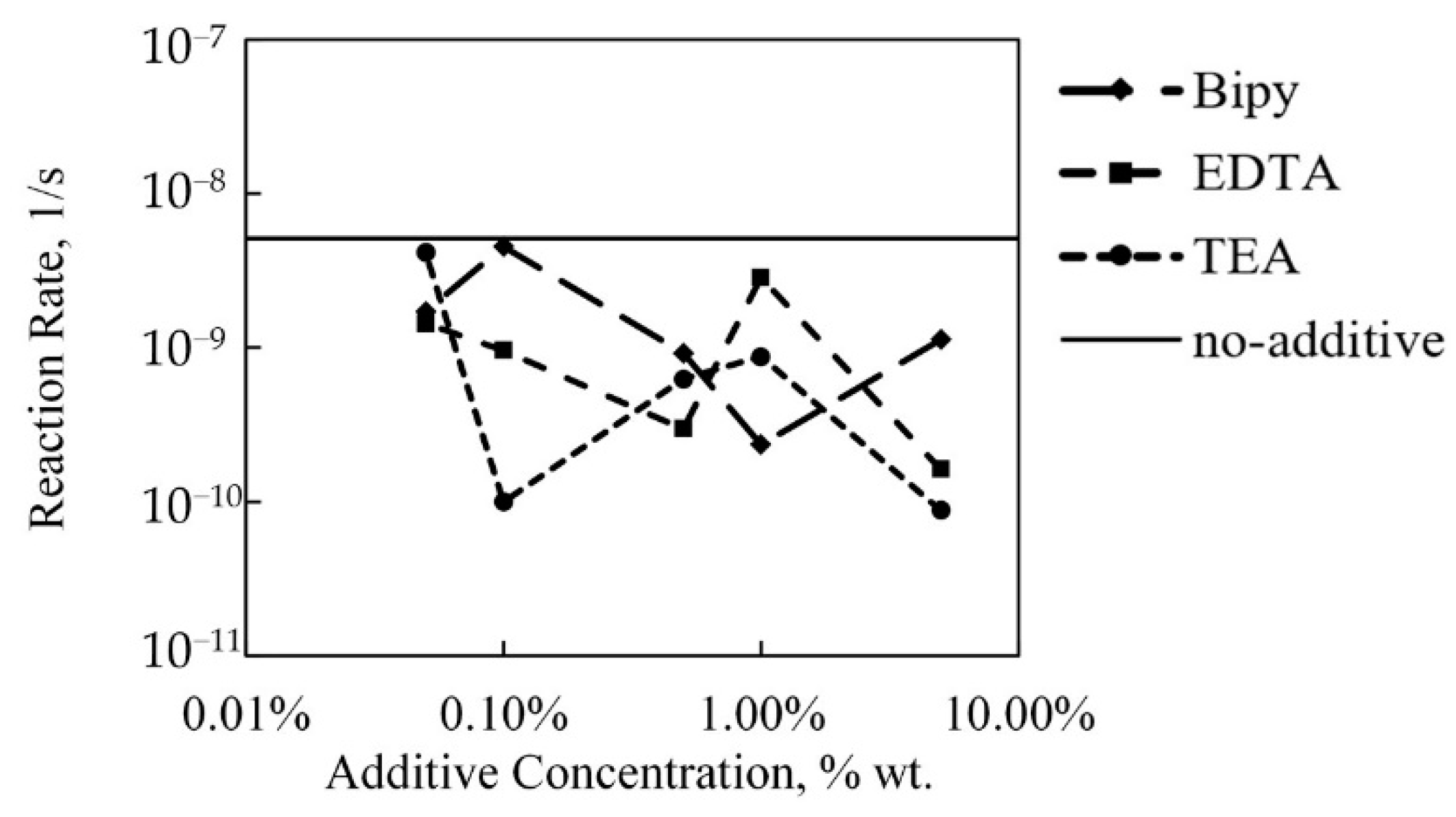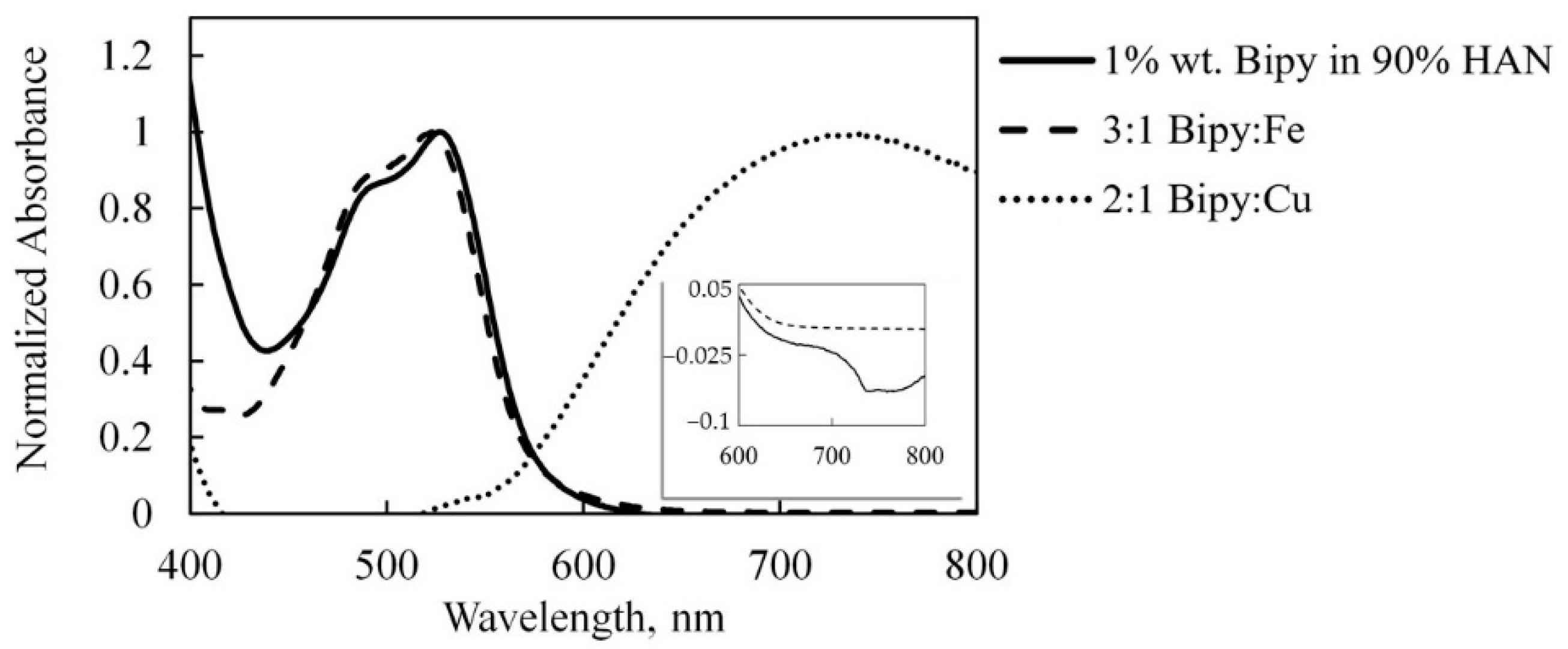1. Introduction
Hydroxylammonium nitrate (HAN) based propellants have recently been flight-tested on multiple spacecraft [
1,
2], and have been the subject of research for decades due to an array of useful properties, including but not limited to high density, high specific impulse, low freezing point, and low toxicity [
3,
4,
5,
6,
7,
8,
9,
10,
11]. The low decomposition temperature and ready catalysis of HAN have led energetic materials researchers to study its decomposition mechanism [
12,
13,
14,
15,
16]. Catalytic decomposition and compatibility studies have found that transition metals have catalytic effects on low-temperature decomposition [
3,
17]. This includes common elements like iron that can elute from metallic storage containers.
While catalyzing decomposition is desirable in a combustion chamber, it is not desirable in a storage tank. Tank materials can be changed; however, the current state of the art procedure for synthesizing HAN results in part-per-million concentrations of metal impurities that still have a catalytic effect [
12]. Sequestering metal ions in metal complexes reduces their catalytic activity [
18,
19], which can inhibit the decomposition rate of propellants. Chelating agents are used for their metal-binding ability in a variety of applications including chemical manufacturing, food, medicine, cosmetics, and more [
20,
21,
22,
23,
24]. Chelating agents are ligand molecules capable of forming stable, multidentate chelate complexes with metal ions, effectively sequestering the ion from reacting further [
20]. One such molecule,
N,
N’-disalicylidene-1,2-propanediamine, is known as Metal Deactivator Additive (MDA), and has been studied for use as a stabilizing additive in aviation fuels [
18,
25]. MDA is not used in this study because it is soluble in nonpolar oils and solvents (e.g., hydrocarbon fuels), but not in water.
HAN is a salt with chemical formula [
][
] that separates into hydroxylammonium (
) and nitrate (
) ions in solution according to Equation (1):
The proton transfer between these two molecules, according to Equations (2) and (3), controls the concentration of
in HAN solution, and thereby, the pH of the solution:
HAN has a low pH because
is a strong acid and
is not a strong base. The proton transfer mechanism was found to be the most sensitive mechanism affecting the decomposition of HAN. Experiments done by Zhang found that adding
until the concentration of
was quintupled increased the overall decomposition rate by roughly 50 times, while reducing the concentration of
by adding
reduced the overall rate of decomposition [
6]. Excess
available in solution allows for the accumulation of additional
and
by Equations (3) and (4), respectively, leading to the formation of decomposition products
and
as shown by Zhang’s nitration/nitrosation pathway (Equations (4)–(8)) [
6]:
This decomposition pathway also gives a mechanism for HAN autocatalysis, since the number of
produced by these reactions is higher than the number of
required to start them. The more classical reduced kinetic model of Lee and Litzinger [
5] includes Equation (9), which is analogous to Equation (4), citing it as the most dominant pathway for
decomposition:
Chelating additives may affect the decomposition of HAN through two different mechanisms, and it is important to separate their effects. The initiation of decomposition of HAN requires available . While chelating additives may sequester metallic ions and slow the decomposition rate, they may also change the catalytic activity of the concentration. Chelating additives are molecular species that may either dissociate to add more to the HAN solution or combine with to remove it through acid dissociation and recombination. Equation (2) is an example of acid dissociation and recombination of a molecule. The change in concentration can be measured as a change in acidity (pH) of the solution. Both metal chelation and concentration change the decomposition rate of HAN. To isolate the effect of metal chelation on decomposition rate, the acidity of HAN solutions with chelating additives must be monitored.
Chelating additives may also decrease the decomposition rate of HAN by sequestration of metal ions. Metal ions catalyze the decomposition of HAN by assisting in oxidation of HAN through reactions such as Equation (10), a dihydroxylamine (
) formation proposed by Hansen et al. This reaction occurs especially when the metal atom is one that readily changes its oxidation state, such as iron or copper. In Equation (10), the iron ion is reduced from 3+ to 2+ oxidation state, and the hydroxylamine gains an oxygen, turning into dihydroxylamine:
Surplus nitric acid is produced in Equation (10), and may further contribute to the decomposition of HAN by increasing the solution acidity, or through reactions like Equations (11) and (12). For a trace amount of iron to contribute to decomposition, the
ions must be oxidized back to the
ion by losing an electron so that they can be recycled to participate in Equation (10) again. Hansen et al. [
3] propose a method of iron oxidation that uses available nitrate ions and contributes to the production of product species nitric oxide and water, as shown in Equation (11):
Hansen et al. propose another iron oxidation mechanism where the
reacts with HAN, reducing the hydroxylammonium ion into an ammonium ion, while oxidizing the
into
[
3]. Equation (12) prepares the iron ions to participate once again in Equation (10), and contributes to the decomposition of the HAN components into product species such as water and ammonia:
Equations (10)–(12) together are proposed by Hansen et al. as part of an explanation for the autocatalytic behavior of HAN [
3]. In the presence of even trace quantities of metal ions, this set of reactions may recycle metal ions as a reactive species capable of breaking apart HAN at every step. In addition to the direct contribution to the decomposition of HAN by reaction with metal ions, the dihydroxylamine species produced in Equation (10) is unstable and undergoes disproportionation, as shown in equation 13 or 14:
where the product species nitrous oxide and water are formed, or:
where nitrous acid is produced that increases the solution acidity and thereby catalyzes the decomposition of HAN.
The aim of this study is to determine if chelating agent additives have an effect on the decomposition of HAN. Equations (10)–(12) illustrate part of a metal-catalyzed decomposition mechanism that may be inhibited by chelating additives, motivating the use of these additives in this work. With a systematic approach using multiple thermal analysis methods and isolating the effects of changes in pH, we show for the first time the effect of chelating agents on neat HAN with trace metal impurities and no additional user-added metals. These trace metals impurities are measured by ICP-MS, and the iron content is confirmed by colorimetric analysis. This is the first body of work to investigate the effects of chelating agent on single part-per-million order metal concentrations. Previous work has investigated user-added metals on the order of 100 parts-per-million [
13,
15]. Effects on decomposition are evaluated using thermogravimetric analyses (TGA) to calculate decomposition temperature, isothermal decomposition rate, and first order Arrhenius reaction rates to compare propellant samples with and without chelating agent additives. This work shows, for the first time, that Bipy inhibits the decomposition of HAN at 348 K and atmospheric pressure. Additionally, iron and other heavy metal impurities are found in trace quantities in neat, unadulterated HAN.
3. Discussion
3.1. Comparing Isothermal Results with pH
The results for isothermal decomposition at 348 K of 1% additive samples compared with those of the no additive sample showed that while Bipy can inhibit the decomposition of HAN, TEA has a significantly lesser inhibitive effect, and EDTA can even catalyze decomposition. These results showed that a mechanism based on alone does not adequately explain the inhibitive effect of Bipy on the decomposition of HAN. After 48 h, the sample with 1% Bipy had 1.3% more mass remaining than the HAN sample with no additive. Although this was a small difference, it was significant, since the TGA measurement error was sensitive to 0.00033% of the 30 mg sample. The TEA sample had just 0.13% more mass remaining than the sample with no additive, and the EDTA sample ended the 48-h test with 0.36% less mass than the sample with no additive. These results showed that Bipy and TEA inhibited the decomposition of HAN at 348 K.
Additionally, 1% Bipy provided five times the inhibition to isothermal mass loss rate of HAN compared to 1% TEA, suggesting that changing the pH is not the only mechanism by which Bipy and TEA affect the decomposition of HAN.
The acid dissociation constants of the protonated form of the chosen additives are given in
Table 3 for the dissociation of each chelating agent into
and its conjugate base. EDTA can be written as H
4EDTA to note the hydrogens in the acetic acid groups that would be the first to dissociate. These notations refer to the same molecule.
The acid dissociation constants (pK
a) of protonated Bipy and TEA are both higher than the 2.8 equilibrium pH of 90% aqueous HAN, so these species were not expected to release additional
ions when dissolved in solution. Instead, they were able to bond with free
ions, recombining into their protonated form. Protonated EDTA has two acid dissociations with a pK
a less than the pH of the HAN solution; therefore, EDTA was expected to release two
per molecule. Releasing additional
catalyzes the decomposition of HAN, overshadowing any metal sequestration properties. The effect of acid dissociation was observed in the pH measurements of HAN solutions with 5% w/w additive concentrations, as shown in
Figure 1.
Figure 1 shows that acid dissociation of higher concentrations of each additive changed the sample to a lower pH for EDTA and a higher pH for Bipy and TEA.
The pH of the samples were measured and compared with data at 298 K and 1 atm. This was the relevant regime for the formation of chelate complexes in HAN solutions before use, but pH and pKa properties of samples may have changed based on the elevated temperatures and decreased water content during TGA testing. For example, with less water in the mixture and at elevated temperature, the pH was expected to decrease. In theory, this could change whether the additives dissociate or recombine with free ions. However, the isothermal decomposition rates reflected the comparison of pH and pKa values at room temperature, so while the actual values may have changed, their comparison remains valid. The same logic applies to the stability of each chelate complex, and in particular, Bipy. If the stability of Bipy complexes were compromised by the elevated temperature and decreased pH, then no decomposition inhibition should have been observed past that expected by its acid recombination.
If -based mechanisms were the only way that these additives affected the decomposition of HAN, then TEA should have had the best inhibition properties, because it has the highest pKa. Therefore, pH does not adequately explain why Bipy had five times the inhibitive effect on HAN isothermal mass loss rate. Spectrophotometry results indicated that sequestration of iron by Bipy was a possible explanation for its relative effectiveness.
3.2. Decomposition Onset Temperatures
Like the results for isothermal mass loss rate, the results for decomposition onset temperatures showed that Bipy, TEA, and EDTA affected the decomposition of HAN differently. Bipy samples showed a 7.0 K increase in the decomposition onset temperature compared with no additive, while TEA and EDTA did not yield a clear change. Additionally, none of the samples showed a significant dependence of decomposition onset temperature on the additive concentration in the range investigated. The method of calculating decomposition onset temperature was heavily dependent on the maximum mass loss rate, and was potentially influenced by procedural error, obscuring meaningful results from the TEA and EDTA data.
The maximum mass loss rate was sensitive to small changes in the shape of the mass loss curve. If an error occurred that affected this small section of the TGA curve, the decomposition onset temperature calculated from the TGA curve changed significantly. When the sample reacted endothermically, the TGA thermogram sometimes doubled back on itself as the measurement thermocouple briefly measured a lower temperature. This sometimes rapidly flipped the sign of the derivative, making the determination of the maximum mass loss rate less clear. These were consequences of HAN decomposing quickly, losing the bulk of its liquid mass in seconds, and thereby amplifying random errors due to large variations in decomposition onset temperature.
The decomposition onset temperatures for HAN started to plateau at and above 10 K/min. This was because the heating rate became faster than the thermal diffusion and bulk heating of the sample, such that the decomposition started at its maximum rate and temperature each time. To minimize the influence of the heating rate, decomposition onset temperatures acquired at or above 10 K/min heating rate were compared, as shown in
Figure 7. According to the decomposition onset temperature data, Bipy samples produced a consistently higher decomposition temperature than HAN without any additive.
Figure 7 shows visually the average and range of onset temperatures measured with and without additives for the data above 10 K/min heating rate. Above 10 K/min, the average onset temperature for Bipy was 461.8 K, while that for HAN without any additive was 454.8 K. The 7.0 K difference between these decomposition onset temperature averages was larger than the range for both Bipy-added and HAN onset temperatures, making it a significant difference.
Ranges of 23.1 and 30.6 K for TEA and EDTA respectively eclipsed the observed differences between the average onset temperature with and without each additive while the 5.2 K range observed for Bipy samples did not. Therefore, the only conclusion that can be made from the TEA and EDTA series is that the decomposition onset temperature was more unstable for samples containing these additives compared those containing Bipy or no additive. Despite any error, samples containing Bipy or no additive exhibited a smaller range of decomposition onset temperatures, leading to the conclusion that Bipy inhibited the decomposition of HAN.
3.3. Reaction Rate Parameters and Kinetic Compensation
Reaction rate parameters are calculated as an additional method for examining the influence of additives on the reaction rate. These rate parameters follow a proportional trend established in the literature, thought to be due to the kinetic compensation effect (KCE) [
33,
34]. Since the rate parameters agree with those in the literature, it shows that the reaction phenomena—i.e., the decomposition of HAN—observed by the TGA methodology applied in this study were the same as those reported in literature [
35].
Reaction rate parameters are theoretically independent of heating rate, and make it possible to estimate the rate of the reaction itself, according to a couple of assumptions. In this work, the first order Arrhenius reaction rate parameters were fit from experimental TGA data using the Ozawa/Flynn/Wall (OFW) method [
36,
37,
38]. The first order reaction rate formulation is:
where for any reaction of rate
,
is the pre-exponential frequency factor,
is the temperature,
is the universal gas constant, and
is the activation energy in the same units as
.
and
have units of s
−1, while the
is a unitless fraction of molecules with threshold energy
available.
The reactions observed by TGA were analyzed by a nondimensional fraction of sample reacted (
), equivalent to the mass percent. The OFW method uses Doyle’s approximation for the temperature integral [
36,
37,
38,
39,
40]. In this work,
is used as recommended by the ASTM E1641-16 standard and TGA system manufacturer TA Instruments [
38,
39]. The choice of a linear conversion function
assumes that the reaction is a single-step, global reaction, providing accurate results for complex decompositions when there is a single rate-limiting mechanism [
40].
Conversion points and heating rates from TGA thermograms at rates of 2, 5, 10, 15, and 20 K/min of 90% aqueous HAN without additive were used to produce a sample Arrhenius plot of log heating rate vs. inverse temperature, as shown in
Figure 8. The linear fit shown on the plot is for a no additive sample and has slope −9344.9 K
2/min and y-intercept 23.816 K/min. This fit generated a coefficient of determination (R-squared) of 0.987, showing that although imperfect, the linear fit appears acceptable for the onset region of HAN decomposition where
is low. The error in activation energy was calculated from the uncertainty in the slope, as determined by linear regression with the fit shown in
Figure 8 as recommended by the ASTM E1641-16 standard [
39]. For the data in
Figure 8, the activation energy and pre-exponential factor were found to be 171.5 ± 11.4 kJ/mol and 40.2 ± 1.2 s
−1.
For each HAN sample, the calculated first-order activation energy and frequency factor for each propellant sample are plotted in
Figure 9. In
Figure 9, the horizontal line represents the HAN sample without additive. The samples with additive had a higher activation energy. Higher activation energy indicates, in theory, that the decomposition for those samples is inhibited; however, this may not be true, due to kinetic compensation. Specifically, since the chosen conversion point (the value of
) was 0.05, this reaction rate was the rate for the first 5% of the sample to decompose. The vertical bars represent the linear regression error associated with the fit of the reaction rate parameters. As predicted by the KCE, the trends in the activation energy results appeared to be very similar to the results for frequency factor.
Computational and experimental work elucidated the mechanisms of the decomposition of HAN, and allowed us to calculate the rate constants of each [
6]. Some of the rate constant parameters for HAN from the literature are shown in
Figure 10, where they are compared with those calculated in this work. A positive, linear correlation between frequency factor and activation energy is clear. This is an observation of the KCE, which states that the frequency factor is a result of the Arrhenius rate equation formalism [
33,
34]. When a procedural change is made that changes the activation energy, a frequency factor is calculated that abides by the linear compensation law,
where
and
are linear fit coefficients. This linear relationship is an implicit assumption in numerically fitting experimental data to the Arrhenius rate equation. Activation energy and the frequency factor are fundamentally coupled for complex reaction phenomena that include many steps and intermediate species, such that the physical description of ‘frequency factor’ is dubious at best. The linear fit parameters
and
in Equation (10) for the data collected by Zhang were −3.497 s
−1 and 446.3 K, respectively [
6]. For the data from this work,
and
were −9.887 s
−1 and 418.2 K.
The parameters from this work neatly created a linear kinetic compensation trend and exhibited consistency with rate parameters measured elsewhere. The parameters calculated in this work were each at a higher activation energy and frequency factor, except for the outlier from Kondkrikov’s work. This was expected, as the final value of the rate parameters are highly dependent on sample and experimental conditions, as discussed by Brill et al. The differing range of reaction rate parameters may also have been dependent on the conversion point used for calculating the parameters, or the method itself. Using a conversion point of effectively ignores the decomposition of the last 95% of the mass. This works around the issue in decomposition onset temperature calculation, i.e., depending on the maximum mass loss rate; however, the calculation of reaction rate parameters presents its own inaccuracies.
Due to the similar magnitudes and frequency factor versus activation energy trend, there was considerable overlap of the reaction phenomena being observed. It should be no surprise that a complex physical phenomenon such as the decomposition of HAN is inadequately described by an equation with two varying parameters. Nevertheless, fitting Arrhenius reaction rate parameters with a repeatable degree of kinetic compensation, as shown by the agreement between many studies (see
Figure 10), indicates that the same reaction phenomena were being observed [
35].
3.4. Reaction Rate Inhibition
Even though the frequency factor and activation energy parameters were coupled, the reaction rate calculated at 348 K appeared to be inhibited. However, the series for each additive showed similar variation and a similar trend. Due to the similarity of the reaction rate results for each additive, the inhibitive or catalytic effects of the additives tested were found to be too small to be captured by the OFW method of determining reaction rate parameters. This indicates that although Bipy, TEA, and EDTA were observed to affect the decomposition of HAN according to results from isothermal TGA and onset temperature calculations, they did not significantly change its rate-limiting mechanism. The differences calculated in reaction rate must therefore have been artefacts of the measurement and postprocessing procedure.
In
Figure 11, the data from
Figure 9 are used to calculate reaction rates using a temperature of 348 K, i.e., the same temperature used in isothermal tests. The reaction rate parameters, as shown in
Figure 9, were clearly coupled to each other due to the KCE. Despite this coupling, the kinetic reaction rate exhibited a decreasing trend with increasing additive concentration to a lower reaction rate than measured for no additive samples. However, the series for each additive produced similar decreasing trends, each with similar variance. This was in contrast with the isothermal decomposition and onset temperature data where Bipy showed an inhibitive effect, while TEA and EDTA showed a catalytic or no significant effect. Therefore, the decreasing kinetic rate calculated at 348 K was attributed to errors from inaccurate assumptions regarding the application of the OFW method.
Independent of the reported error from linear regression on the Arrhenius plot, there were inaccuracies arising from the assumptions of a first order reaction rate, Doyle’s integral approximation, and the use of a linear conversion function. Approximating the decomposition of HAN as a single-step, first-order reaction should be reasonable for HAN, since its autocatalysis has been found to be mainly dependent on proton transfer to hydroxylamine [
6]. The proposed mechanism, by which chelating additives are proposed to inhibit the decomposition of HAN, is not the primary acid catalyzed mechanism. This was confirmed by the lack of serious change in the reaction rates that should correspond to the isothermal TGA results.
Alternative methods for solving the Arrhenius equation and fitting reaction rates using alternate temperature integral solution methods or conversion functions are discussed by Vyazovkin et al. The method used in this work was chosen for its simplicity, but other methods of approximating kinetic models might better capture the secondary nature of the effect of chelating agents compared to the primary proton transfer mechanism. Notably, methods that use longer time scales such as combining multiple isothermal measurements to calculate rate parameters might produce better results. Hansen observed that some chelating agent additives extended the lifetime of HAN samples observed over multiple weeks [
3]. It stands to reason that the secondary effect of chelating agents becomes more pronounced at lower temperature and pressure conditions, and on longer time scales where the secondary metal-catalyzed mechanism has time to compete with the primary acid-catalyzed decomposition mechanism.
3.5. Bipy Complex Absorbance and Speciation
The absorption peaks found in the results from visible spectrum spectrophotometry confirmed that the aqueous HAN contained metal ions in trace quantities, and that Bipy formed chelate complexes with them.
The absorbance peak located at 527 nm in
Figure 2 corresponded with the expected peak absorbance for [Fe(bipy)
3]
2+ at 522 nm, allowing for a slight redshift [
26]. The peak absorbance for [Fe(bipy)
3]
3+ was at 610 nm, i.e., outside the measured absorbance signal due to iron; therefore, all measured complexes were assumed to be [Fe(bipy)
3]
2+ [
26]. The relative intensity of this peak could be used to estimate the iron concentration. According to the Beer-Lambert law, the fractional intensity of light that is absorbed by a molecule in solution is proportional to the concentration of that molecule in the solution. For the first order, the Beer-Lambert law is
where
is the absorbance of a particular wavelength of light, measured by the decadic logarithm of the ratio of light transmitted through the reference to the intensity of light transmitted through the sample. In the absorption spectrum of the 1% Bipy sample in
Figure 2, there was a concentration of Bipy four orders of magnitude greater than the expected concentration of iron; therefore, only saturated Bipy:Fe complexes with three Bipy molecules were expected to be present. Schilt gives the molar absorptivity for [Fe(bipy)
3]
2+ and [Fe(bipy)
3]
3+ as 8650 and 330 M
–1 cm
–1, respectively [
26]. Using the absorptivity of [Fe(bipy)
3]
2+ along with the measured peak absorbance at 527 nm, a concentration of 1.2 ppm Fe was found. This corresponded well with the 0.9 ppm measured with ICP-MS (
Table 1), and further confirmed the existence of trace metal impurities, including iron. It also indicated that iron ions had been sequestered by Bipy at the equilibrium pH of HAN.
The wavelength of light absorbed corresponds to the physical properties of the complex that absorbs the light. This means that complexes of different metal ions with different sizes absorb different wavelengths of light, and that each individual absorbance peak corresponds with either a complex of a different metal species or a complex with different numbers of Bipy. For example, a different wavelength may be observed for complexes with ratios of 2:1 Bipy:Fe, 3:1 Bipy:Fe, and 2:1 Bipy:Cu. The absorbance peaks measured for HAN were compared with those for Fe+Bipy and Cu+Bipy solutions, all of which were normalized to the peak absorbance shown in
Figure 12. The 3:1 Bipy:Fe ratio and 2:1 Bipy:Cu ratio spectra are presented, because iron commonly has a coordination number of six, while copper commonly has a coordination number of four. It was therefore expected that the 3:1 and 2:1 Bipy:Fe and Bipy:Cu, respectively, would be the most stable complexes in a solution with excess Bipy, with all the metal ions’ coordination sites filled.
The wavelength of peak absorbance for copper is 742 nm, while those of Fe+Bipy and 1% Bipy-HAN are both 523 nm. Furthermore, the Fe+Bipy and Bipy-HAN samples showed the same secondary peak at 495 nm. The zoomed-in inset shows that there was no significant absorbance at 742 nm in the 1% Bipy in HAN sample. The fluctuations observed in the inset were most likely the amplification of noise by the zero/baseline correction. These results suggest that adding Bipy to a HAN solution with trace iron content causes Fe+Bipy complexes to form with no noticeable copper complexes. This implies that the effect on decomposition rate and activation energy observed due to Bipy were due to chelation and the sequestration of iron. The presence of iron and lack of significant copper complexes in 90% HAN is visually confirmed in
Figure A4, where adding Bipy and copper results in a purple solution instead of the expected red-pink color indicative of iron complexes or blue color indicative of copper complexes. In the case of a purple color, both complexes are present.
5. Conclusions
HAN samples using 90% w/w aqueous HAN as solvent were made with and without chelating agent additive. Using data obtainable by the same TGA machine, multiple methods of analysis were performed on these samples, including isothermal TGA and dynamic TGA using multiple constant heating rates, which allowed for the calculation of the isothermal decomposition rate, the decomposition onset temperature, and first order Arrhenius reaction rate parameters. In the present research, 2,2′-bipyridine (Bipy), triethanolamine (TEA), and ethylenediaminetetraacetic acid (EDTA) were studied as 0.05, 0.1, 0.5, 1, and 5% by weight additives in 90% aqueous HAN by weight.
An isothermal decomposition rate of 0.137%/h at 348 K was observed for HAN at 348 K. The addition of 1% Bipy and 1% TEA reduced the isothermal decomposition rates by 20.4% to 0.109%/h and by 3.65% to 0.132%/h, respectively. The addition of 1% EDTA increased the isothermal decomposition rate by 12.4% to 0.154%/h. The isothermal results imply that there are other relevant mechanisms at play, like pH-dependent complex stability and acid dissociation, indicating that chelating ability alone is not a good qualifier for an additive to HAN-based propellant.
Bipy was found to increase the decomposition onset temperature from 454.8 K to 461.8 K, while TEA and EDTA made the this value more unstable without significantly changing it. The first order reaction rates calculated by the Ozawa-Flynn-Wall (OFW) method were found to be insufficient for capturing the effects of the tested additives. The reaction rates did, however, neatly fit into the positive trend of pre-exponential vs. activation energy parameters, due to the kinetic compensation effect. This showed that the decomposition mechanism studied in this work was the same as those in other studies in the literature.
Spectrophotometric results showed that Bipy formed complexes with both copper and iron in solutions at the same equilibrium pH as 90% HAN. Comparing these results with 1% Bipy added to 90% HAN showed that there were trace iron impurities on the order of 1 part per million, and that these formed chelate complexes with the added Bipy. The results of ICP-MS indicated that there may have been other trace metal impurities in the HAN that catalyzed it through a secondary decomposition mechanism.
Bipy, a chelating agent that forms complexes with trace quantities of iron, was found to reduce the decomposition rate of HAN, but only in the low-temperature limit, observed in this study at 348 K. Chelating agents that form stable metal complexes at low pH such as Bipy were shown to increase the storage stability by decreasing the rate of decomposition in the low temperature and long timescale limit. To effectively inhibit the decomposition of HAN, the additive must also have a pKa higher than 2.8, such that no acid dissociation occurs. This effect was observed even at part per million concentrations of metal impurities. In the fast, high-temperature decomposition of HAN, pH plays a much greater role than the effect of complexing metal impurities. Future work should directly investigate the effect of pH-neutralizing additives on the decomposition of HAN to find whether targeting the primary decomposition mechanism can have a greater inhibitive effect in storage conditions.
